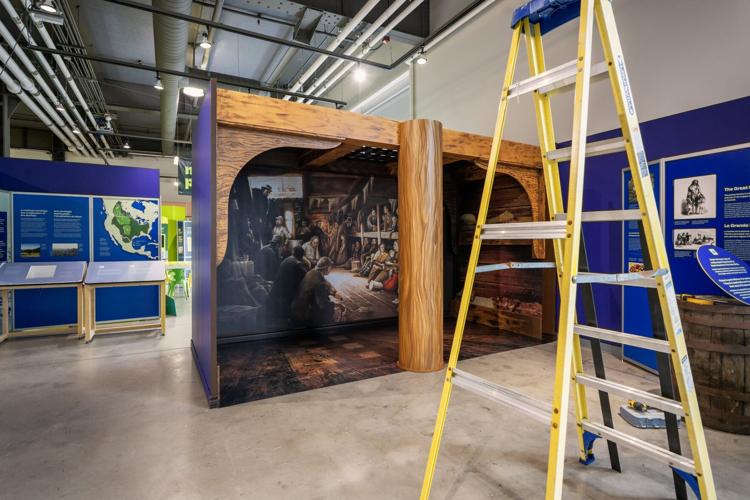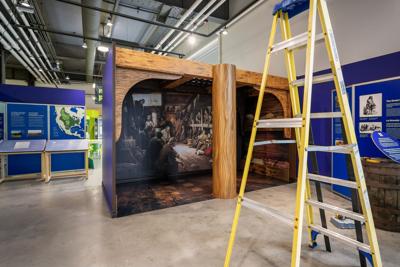From Chinese chow mein in Newfoundland to California rolls in Vancouver to recipes that survived the Holocaust, food has often been overlooked as part of Canada’s immigration history.
While Canadians’ taste buds have benefited from diverse cuisines introduced by generations of immigrants, stories about food and immigration can be lost. Yet food is a key ingredient that connects people to the past, to places, and to other people.
“Everyone loves talking about food and it’s something that’s so universal,” said Sara England, curator of temporary and travelling exhibitions at the Canadian Museum of Immigration at Pier 21Ìýin Halifax. “But it goes so much deeper. People have such an emotional connection to food.”
On Saturday, the museum is openingÌý openingÌýthe exhibitionÌýÌýwhich explores the connections between food andÌýimmigration in Canada. It will run until Jan. 18 before it travels across the country, including a stop in Greater pc28¹ÙÍønext year.
Food “connects to the ideas of home, maybe your homeland,” England said. “It connects to family. It connects to our grandmother’s recipes. It holds so much in terms of people and place. All of that connects really well to thinking about immigration history through the lens of food.”
Among the food-related artifacts showcased in the exhibition is an almostÌý, who was interned at the Ravensbruck concentration camp, was liberated and immigrated to Canada in 1951. It’s a loan from the Vancouver Holocaust Education Centre.
“During her time there, she and the women in her camp, her fellow prisoners, would talk about food,” said Kristine Kovacevic, the immigration museum’s curator of core exhibitions.
“Rebecca actually stole paper and a pencil from an office in the camp to start to record those stories and those recipes of food that they were all sharing at night at a huge risk to her life, which just shows the importance of food and memory and that idea of food being connected to safety and freedom.”
The exhibit also features stories of Vancouver chef Hidekazu Tojo, inventor of the California roll; donair, a variation ofÌýdoner kebab or gyroÌýinvented in Halifax by Greek immigrant Peter Gamoulakos; and joumou, a squash-based soup with beef that used to be reserved for French slaveholdersÌýand which Haitian Canadians still eat on Jan. 1 to celebrate independence.Ìý
AÌýpart of the exhibition also looks at the regional dishes across Canada and how Chinese restaurateurs have adapted to local tastes and local ingredients.
England said immigrants make up more than half of the food and beverage business owners in Canada, and many early Chinese immigrants settled in Canada and opened restaurants because it was one of the few occupations that they weren’t barred from doing.
“The dish, chow mein, which we know to be noodles, was actually replaced with thinly sliced cabbage in Newfoundland instead, because it was something that was readily available and appealed to local tastes in a way that would be more comfortable for local patrons,” she explained.
“In Timmins, Chinese food is served with a side of toast, so there’s all these interesting variations where you make adaptations to survive as a business but also has a way of picking up steam and becoming integrated into the local cuisine.”Ìý
Taking up 3,000 square feet of spaceÌý— 1,500 for the travelling edition — the exhibition explores how hunger drove people to Canada such as the famished Irish during the Great Hunger;Ìýthe way immigration has shaped how we eat; stories and history behind food dishes with Canadian connections; as well as food traditions, culture and festivals.
In addition to an immersiveÌýoral history collection of interviews with immigrants talking about their experiences with food, the show recreates a kitchen, a living room, a Chinese restaurant takeout counter, and has other props for ambience. There’s also a children’s play kitchen.
Recipes are spaced out throughout the exhibit and visitors can scan the QR codes to a website to find ingredients, measures and directions.
There are displays of immigrant food and restaurant photos, plus activities that inviteÌývisitors to share how they connect to food and what food reminds them of. One game, called “the ingredient wheel,” ask people to spin various rings to align a mixture of Indigenous and immigrant ingredients to re-imagine a dish of their own.
Kovacevic said the exhibition has been long time coming, born out of responses over the years by visitors to the museum who were asked to write about their culture and put it on a magnetic wall; 95 per cent of people mentioned something about food. It would take two years of research, community consultation and licensing to make the exhibition happen.Ìý
Canada’s diverse food opens the door for people to talk and to share their culture, she said.
While the exhibition, made possible with aÌý$500,000 gift from BMO,Ìýcannot show real food on site due to health and safety concerns, it promises visitors plenty of food for thought.
“Some of the things that they can expect is to feel nostalgic,” saidÌýKovacevic, and to leave “feeling really curious to learn more about themselves or about others through the lens of food.”
The travelling exhibition is scheduled to open at the Joseph Brant Museum in Burlington on April 18, 2026. The show has been tentatively booked across the country till 2030.

































To join the conversation set a first and last name in your user profile.
Sign in or register for free to join the Conversation